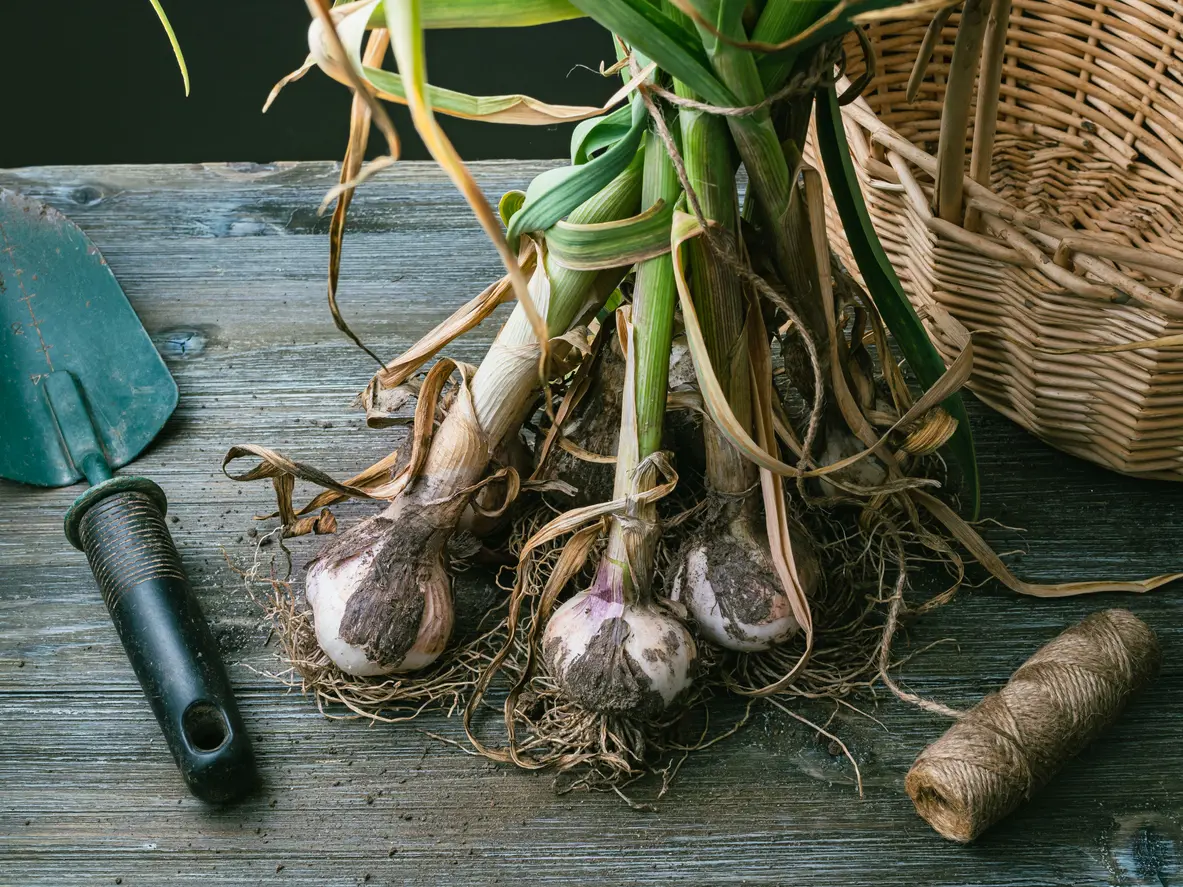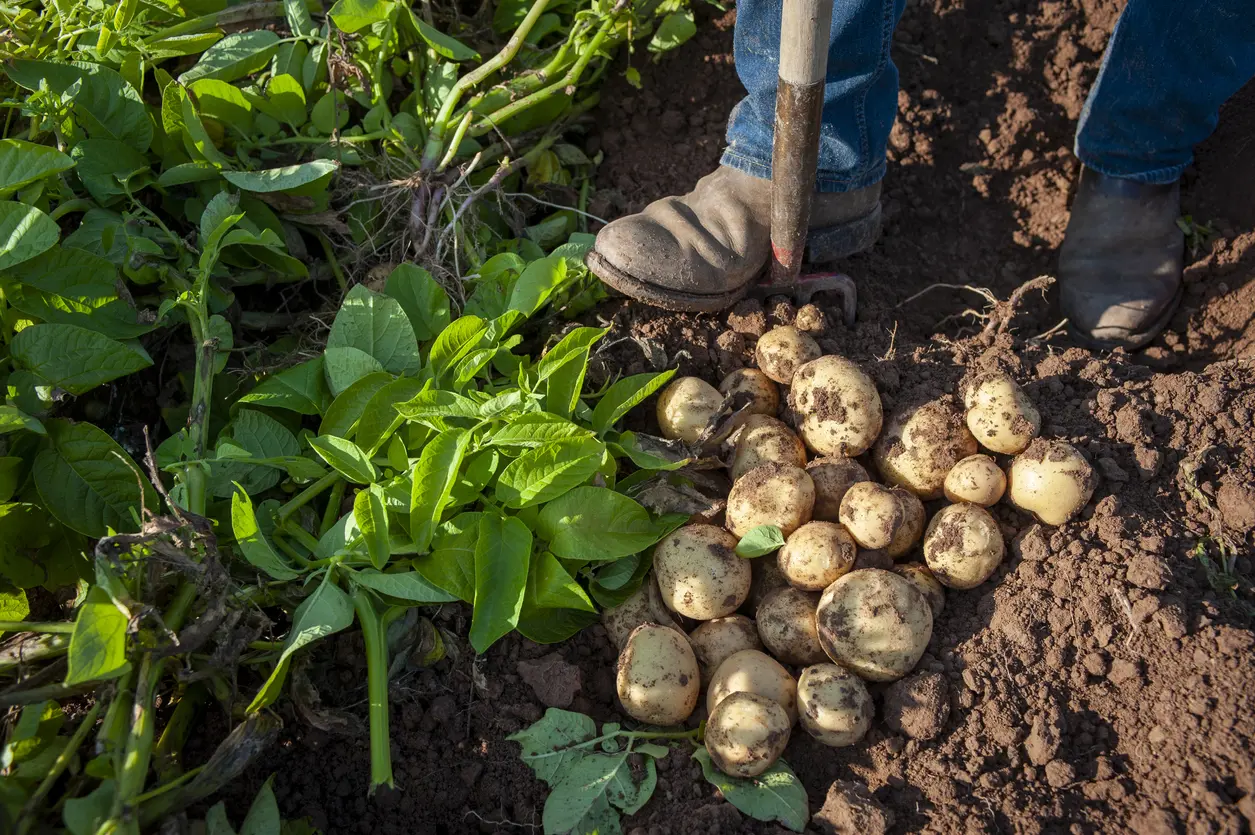
Garlic is a staple in the kitchen for many home cooks and chefs. Whether you like a little flavor or an aromatic punch, growing garlic is a must in your garden, especially if it’s a grocery store staple.
This garlic growing guide will suit any garden setup, from single containers to large in-ground beds. As long as you follow the spacing and soil requirements, you can grow garlic in just about anything.
Keep reading to learn how to grow garlic at home so you can always enjoy that garlicky goodness.
Types of Garlic
Before you learn how to plant garlic, you should first learn about the two main types. Though they’re grown similarly, the end product and storage process differ.
Hardneck Garlic
Hardneck garlic is typically a chef’s preferred choice thanks to its sharp flavor. They only last up to four months in storage, so use them quickly. If you don’t use a lot of garlic at home, this won’t be a great variety for you to grow.
Hardneck garlic bulbs grow up to 12 cloves centered around a scape. The scape produces small cloves and eventually seeds. Allowing the scape to produce seeds may take energy away from bulb production, resulting in smaller or fewer cloves. [2] Growing Garlic in the Home Garden; Rutgers New Jersey Agricultural Experiment Station; Phyllis Frederick, Erika Leviant, William Hlubik
Popular hardneck varieties include Asiatic, Continental, Creole, German Red, and Roja. [1] Garlic, Garlic; Oregon State University, February 5, 2010
Softneck Garlic
Unless you know your way around the kitchen, you’re likely more familiar with softneck garlic since it’s typically what’s sold in grocery stores. When cured properly, they can last up to eight months in storage, making it ideal for home gardeners who harvest more than they expected!
Unlike hardneck varieties, softneck garlic doesn’t produce a scape, so a plant’s energy goes straight to the bulb, allowing it to produce more cloves. You can find anywhere from 10 to 40 cloves in layers rather than centered around a scape. Artichoke, Italian, and Silverskin varieties are easy to grow at home and taste lovely in any dish you whip up. [1] Garlic, Garlic; Oregon State University, February 5, 2010 , [2] Growing Garlic in the Home Garden; Rutgers New Jersey Agricultural Experiment Station; Phyllis Frederick, Erika Leviant, William Hlubik
When to Plant Garlic
The best time to plant garlic is in the fall, at least six weeks before the first expected freeze. The cloves will grow roots and small shoots before the first freeze, allowing them exposure to cold temperatures they need, or the bulbs won’t be as productive as you’d hoped.
If you want to plant garlic in the spring, keep cloves in the refrigerator for eight weeks to mimic the winter weather they need. Plant the cloves in late winter or early spring when the weather is still cold. You likely won’t get as bountiful a harvest as a fall-planted crop, but it should be enough to get you through the summer. [4] How to Grow Garlic; University of Illinois Urbana-Champaign; Ken Johnson
Soil and Site Preparation
A prolific harvest begins with carefully cultivated soil. Start by choosing a sunny location. Some shade is okay, but you’ll get better results with at least eight hours of direct sunlight.
The place you plant your garlic shouldn’t have had garlic or onions growing there in the last four years. It also needs to be deep enough to dig eight inches deep to loosen the soil and add organic matter. [5] Garlic: How to Grow It; South Dakota State University Extension; Rhoda Burrows
Garlic needs well-draining soil that won’t hold excessive water while staying moist. Organic matter, like compost or peat, is crucial to ensure the soil has plenty of nutrients to feed the garlic throughout its growing season. It can also loosen clay soil or add structure to sandy soil. [2] Growing Garlic in the Home Garden; Rutgers New Jersey Agricultural Experiment Station; Phyllis Frederick, Erika Leviant, William Hlubik , [3] How to Grow Garlic in Your Garden; Utah State University Yard and Garden Extension
Finally, make sure the soil has the optimum pH value of 6.5 to 7.0. Garlic can make do with 6.0, but you’ll get better results in the ideal range. [1] Garlic, Garlic; Oregon State University, February 5, 2010
How to Plant Garlic
The size of your harvested garlic directly correlates to the size of the clove you plant. Each planted clove will give you one bulb of garlic; planting small cloves results in a humble harvest. Choose cloves that aren’t damaged or diseased, and peel the outer layer off to prepare them for planting.
Make holes about two inches deep, about six inches apart from each other. If you’re planting more than one row, they need at least nine inches between them. Place a single clove of garlic pointed side up in the hole and cover it with soil. [1] Garlic, Garlic; Oregon State University, February 5, 2010 , [2] Growing Garlic in the Home Garden; Rutgers New Jersey Agricultural Experiment Station; Phyllis Frederick, Erika Leviant, William Hlubik
How To Grow and Care for Garlic
Knowing how to grow garlic at home will leave you feeling rewarded, especially after enhancing your meals with it. Caring for it as it grows is simple as long as you start out strong.
After planting the cloves, give them a deep drink of water to last them through the winter. Since winter isn’t an active growing season, they won’t need any more water until spring. [1] Garlic, Garlic; Oregon State University, February 5, 2010 , [2] Growing Garlic in the Home Garden; Rutgers New Jersey Agricultural Experiment Station; Phyllis Frederick, Erika Leviant, William Hlubik
After watering, cover your cloves with three or four inches of mulch or grass clippings that are free of pests, diseases, and weeds. Keeping them covered with a generous layer of mulch is crucial if temperatures dip below 20 degrees Fahrenheit, since that kind of cold weather can damage the garlic and negatively impact the upcoming harvest. [2] Growing Garlic in the Home Garden; Rutgers New Jersey Agricultural Experiment Station; Phyllis Frederick, Erika Leviant, William Hlubik , [5] Garlic: How to Grow It; South Dakota State University Extension; Rhoda Burrows
When you notice new growth in the spring, provide your plants with about one inch of water each week. They shouldn’t need fertilizer if you provided them with ample compost in the beginning.
You can continue watering weekly until the leaves begin yellowing. Stop watering to allow the soil and bulb to dry out. Too much water at this stage could result in pest damage or diseases. [1] Garlic, Garlic; Oregon State University, February 5, 2010 , [2] Growing Garlic in the Home Garden; Rutgers New Jersey Agricultural Experiment Station; Phyllis Frederick, Erika Leviant, William Hlubik
When and How to Harvest
After a long few seasons of waiting and watching, you can finally start enjoying the garlic bulbs of your labor! Knowing when and how is crucial to ensure you don’t spoil your harvest prematurely.
When to Harvest Garlic
How can you know when it’s time to harvest garlic? It’s all in the leaves. Bulbs are ready when half of the leaves are yellow or brown and the rest are still green.
If you have any doubts, pull one up and cut into it to see if there’s extra space between the cloves and the skin. If so, they’re not ready. If you wait too long, the bulbs will break apart, and you won’t be able to store them for long. [5] Garlic: How to Grow It; South Dakota State University Extension; Rhoda Burrows
You can also harvest the scapes on hardneck garlic and use them like scallions. They’re ready to eat once the stalk begins curling. If you want to harvest bulbs prematurely, you’ll have something called “green garlic” that can be enjoyed raw or cooked in meals. [2] Growing Garlic in the Home Garden; Rutgers New Jersey Agricultural Experiment Station; Phyllis Frederick, Erika Leviant, William Hlubik
How to Harvest Garlic
When your garlic is ready to harvest, wait for a sunny day so the soil and plants remain dry. It’s better to dig up the bulbs with a trowel since pulling on the plants could tear them apart.
Dig around each plant, leaving plenty of room so you don’t accidentally nick the bulb. Lift the plant out of the loosened soil and shake off the soil. Don’t rinse the plants off; wait until you cook with them to do so.
Avoid letting the harvested plants sit in the sun for too long, as they’re highly susceptible to sunscald. Try to keep the clove wrappers intact so the bulbs will last longer in storage. [2] Growing Garlic in the Home Garden; Rutgers New Jersey Agricultural Experiment Station; Phyllis Frederick, Erika Leviant, William Hlubik
How to Store Garlic
After harvesting, allow your garlic bulbs to cure for four to six weeks in a dry, cool area to allow them to dry out completely. Once they’re dry, trim the roots and choose how you want to store them. You can braid them into a beautiful and convenient display or store them in a mesh bag for easy access. [2] Growing Garlic in the Home Garden; Rutgers New Jersey Agricultural Experiment Station; Phyllis Frederick, Erika Leviant, William Hlubik
Remember that garlic needs a cold period to sprout, so don’t refrigerate the cloves you want to plant in the fall. Avoid warm room temperatures, as that may also encourage bulbs to sprout. [2] Growing Garlic in the Home Garden; Rutgers New Jersey Agricultural Experiment Station; Phyllis Frederick, Erika Leviant, William Hlubik , [5] Garlic: How to Grow It; South Dakota State University Extension; Rhoda Burrows
Common Problems and Pests
Garlic may be pungent, but it’s not free of pests. Onion maggots are white worms that will munch on bulbs, roots, and seedlings. Remove and destroy infected plants and rotate your crops so you don’t plant onions and garlic in the same beds for a few years. [3] How to Grow Garlic in Your Garden; Utah State University Yard and Garden Extension
Thrips’s feeding habits turn leaves an unsightly grey color and eventually cause them to twist up and die. You can easily remove thrips with water, so check for them early and often.
Garlic is prone to neck rot, a fungal disease caused by excessive moisture around harvest time. Stop watering about a month before harvest to prevent the disease.
Weeds are also a big problem for garlic since they don’t compete well, so use crop rotation and diligent weeding to keep your garlic beds clear of competitors. [4] How to Grow Garlic; University of Illinois Urbana-Champaign; Ken Johnson
Was this article helpful?
-
Garlic, Garlic; Oregon State University, February 5, 2010;
https://horticulture.oregonstate.edu/oregon-vegetables/garlic-1 -
Growing Garlic in the Home Garden; Rutgers New Jersey Agricultural Experiment Station; Phyllis Frederick, Erika Leviant, William Hlubik ;
https://njaes.rutgers.edu/fs1233/ -
How to Grow Garlic in Your Garden; Utah State University Yard and Garden Extension;
https://extension.usu.edu/yardandgarden/research/garlic-in-the-garden -
How to Grow Garlic; University of Illinois Urbana-Champaign; Ken Johnson;
https://extension.illinois.edu/blogs/good-growing/2019-09-17-how-grow-garlic -
Garlic: How to Grow It; South Dakota State University Extension; Rhoda Burrows;
https://extension.sdstate.edu/garlic-how-grow-it






